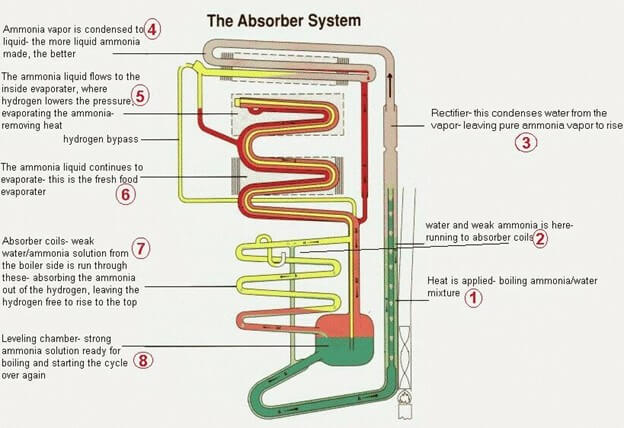Hey! This site is reader-supported and we earn commissions if you purchase products from retailers after clicking on a link from our site.
It’s not unusual for an RV refrigerator to stop getting as cold as it should be, especially over time and if it sits for long periods over time in between uses. In this article, we’ll explain some of those possible causes and how to correct those RV refrigerator problems to keep your unit running as efficiently and properly as possible.
Understanding your RV’s refrigerator cooling system and keeping your RV level
Whether you’re using a 12-volt power supply, the 110-volt power supply or propane to cool your refrigerator, it’s extremely important that your rig is level. Your unit uses ammonium (and hydrogen) gases that must be heated and cooled to keep it at the correct temperature. Yes, I know that sounds odd, but that’s how most refrigeration systems work, so it’s important that all the components in your cooling unit work in conjunction with each other for it to properly cool the inside of the refrigerator.
Simply put, your RV needs to be level, so that the ammonium can be properly heated to circulate through the system. If it’s not, the ammonium will gather in areas away from the electric heating element or propane burners and your refrigeration will be less effective or not cool at all.

This schematic illustrates the absorber system and how it cools your refrigerator. One issue in this schematic that I think should have been better illustrated, is where you begin the process of heating the ammonia.
In the #1 position of the schematic, look for the tube of black lines. The bottom of that tube has what appears to be a candle with a flame and this represents your propane supply of heat which will begin the cooling process. Just above, is an hourglass set of lines which indicates where your electrical element operates if that’s how you’re choosing to cool the refrigerator at the time. However, not shown, is an electrical wire that’s attached to the element.
While this schematic may seem complicated at first glance, it’s not. You’ll need to understand that many of the steps are causally related. For example, step #2 can’t work without steps #7 and #8. With that said, I suggest that you study the schematic and thoroughly understand how your cooling system works just as you did in a previous article where we looked at how to troubleshoot your air conditioning system.
Consider “burping” your RV refrigerator
I know when most folks think about burping, the first thing that many of them picture is holding a small baby after it’s had a bottle of milk and a bit of patting on the child’s back until it lets out a good and healthy belch. For many of my fellow full-time RVers, it could also mean a solid belch after chugging some beer or other carbonated beverages…especially if those drinks are in combination with a fine family during special holiday meal occasions or those that they consider their closest friends.
Instead, this method of troubleshooting your refrigerator involves removing the unit from your rig and giving it a good look over. If you’ve got a workshop or garage it would be best to do this step in an area free of weather as it will take several hours. In fact, it could take a couple of days should you encounter problems with other components such as the heating element of the thermostat.
To begin this process, you should first disconnect the propane gas supply at the base of your refrigerator. This is easily accomplished by using 1-2 excellent quality open end wrenches or one wrench and an equally superior quality pair of lock-jar pliers. If you encounter resistance in this coupling, don’t try to force it to open. Instead, spray some lubricant such as WD-40 into the coupling and let it sit for 15-20 minutes. If it still doesn’t loosen easily, you should have a person that is professionally qualified deal with this issue because if you torque this connection too much, it could rupture the propane line, causing added damage and you’ll need that propane professional anyway (also make sure to read my guide on what to do when your propane isn’t flowing).
The next step is to disconnect your 12-volt electrical supply line which is multi-colored with a quick disconnect connector and the 120-volt power line supply that looks exactly like any power cord you find on any household appliance. Once you have disconnected these corresponding components, you’re now ready to pull the refrigerator out to further maintenance the unit.
Removing the refrigerator
Once you have disconnected the power supply lines and the propane line, you are now ready to remove the refrigerator from its housing. To do this, you’ll need to remove all the screws that are located within the interior of your RV that are positioned on a flashing sheet of metal that surrounds the door of your refrigerator and hold the appliance in place. To save time, I would also suggest that you remove the refrigerator door to make the unit easier to remove. Once you have done these tasks, your refrigerator should slide out easily toward the interior of your RV and can be quickly removed to a work area outside of your rig.
Burping the refrigerator
As a rule, you never want to transport a refrigerator on its side…or at least that’s want people tell you. The truth is, you should never transport a refrigeration unit on its side, then plug it into a power source without giving it time for the refrigerants inside the coils to settle.
This is where the burping of your unit comes into play. Once you have removed your fridge, set it on a clean work surface outside on its side, and after 15-20 minutes, turn it over and let it rest on its other side. Wait the same amount of time then turn it upside down. Be sure to listen to the coils during this process. Can you hear a gurgling sound? If so, that’s a good thing and you are successfully burping your refrigerator.
The final step in this process is to turn the fridge back to its upright position, replace its door to the original location and let it sit for at least three hours so that the liquids within the coils have adequate time to settle back into place. Once this is done, place a thermometer inside the unit and plug it into a 110/120-volt outlet.
I recommend letting it sit plugged into a power source for 18 to 24 hours and then check your temperature within the unit. With any luck, you’ve successfully burped the unit and the refrigerants have gathered appropriately and are correctly cooling the unit.
Still not cold? Check the heating element
While not common, occasionally the heating element can be ineffective. The problem with this diagnosis is that the heating element works with propane heat and electrical heat. It’s designed to give you a temperature regardless of the heat source, so it’s more likely to work accurately with a propane source of heat than that of an electrical heat supply. To check this issue, while you have your refrigerator plugged into the 110/120-volt supply, gently touch the sheet metal flute around where your heating element is located. If it’s hot to the touch, it’s probably working correctly, if not, then it should be replaced. However, if you are near an RV service center, I highly recommend that you take the element to them and have it professionally tested. This part costs $75-$100 and quite often is not the problem. In fact, a heating element is rarely the cause of an RV refrigeration issue. More often, it’s an issue with the thermostat.
Check your thermostat
Use a voltmeter to first check that you have power coming into your unit. The next step is to make sure that the heating element has power to it. If the heating element is not getting any electric, then it’s likely that the problem is with your thermostat. To check the thermostat, take the voltmeter leads and touch them to the red and black wires going into the thermostat with the meter set on the ohms setting. If you don’t have a reading at this point, it means that the thermostat is not getting power and the problem is with your electrical cord or power socket.
On the other hand, if your thermostat is getting power, then use your leads to check the outgoing wires leading to the heating element. If your meter has no reading in the display, then it means that you have no outgoing power from the thermostat to the heating elements and your thermostat will need to be replaced.
Thermostats are relatively inexpensive and are easy to replace, although you may have to do some searching for the one that works with your unit, so you shouldn’t expect to find one in stock at any camping supply store. In fact, it’s likely that you’ll need to order one from the refrigerator’s manufacturer.
With that said my friends, thanks again for following my columns here, and I hope to see you out on the road someday.





